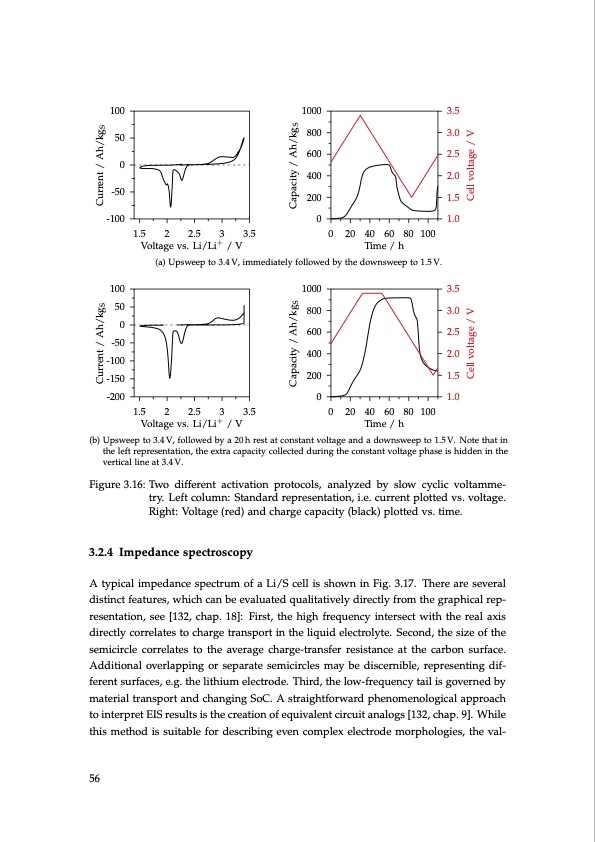
PDF Publication Title:
Text from PDF Page: 056
100 50 0 -50 -100 100 50 0 -50 -100 -150 -200 1000 800 600 400 200 0 3.5 3.0 2.5 2.0 1.5 1.0 3.5 3.0 2.5 2.0 1.5 1.0 1.5 Voltage vs. Li/Li+ / V 2 2.5 3 3.5 0 20 40 60 80 100 Time / h (a) Upsweep to 3.4 V, immediately followed by the downsweep to 1.5 V. 1000 800 600 400 200 0 1.5 Voltage vs. Li/Li+ / V 2 2.5 3 3.5 0 20 40 60 80 100 Time / h (b) Upsweep to 3.4 V, followed by a 20 h rest at constant voltage and a downsweep to 1.5 V. Note that in the left representation, the extra capacity collected during the constant voltage phase is hidden in the vertical line at 3.4 V. Figure 3.16: Two different activation protocols, analyzed by slow cyclic voltamme- try. Left column: Standard representation, i.e. current plotted vs. voltage. Right: Voltage (red) and charge capacity (black) plotted vs. time. 3.2.4 Impedance spectroscopy A typical impedance spectrum of a Li/S cell is shown in Fig. 3.17. There are several distinct features, which can be evaluated qualitatively directly from the graphical rep- resentation, see [132, chap. 18]: First, the high frequency intersect with the real axis directly correlates to charge transport in the liquid electrolyte. Second, the size of the semicircle correlates to the average charge-transfer resistance at the carbon surface. Additional overlapping or separate semicircles may be discernible, representing dif- ferent surfaces, e.g. the lithium electrode. Third, the low-frequency tail is governed by material transport and changing SoC. A straightforward phenomenological approach to interpret EIS results is the creation of equivalent circuit analogs [132, chap. 9]. While this method is suitable for describing even complex electrode morphologies, the val- 56 Current / Ah/kgS Current / Ah/kgS Capacity / Ah/kgS Capacity / Ah/kgS Cell voltage / V Cell voltage / VPDF Image | Lithium-Sulfur Battery: Design, Characterization, and Physically-based Modeling

PDF Search Title:
Lithium-Sulfur Battery: Design, Characterization, and Physically-based ModelingOriginal File Name Searched:
Dissertation_David_N._Fronczek_The_Lithium_Sulfur_Battery.pdfDIY PDF Search: Google It | Yahoo | Bing
Sulfur Deposition on Carbon Nanofibers using Supercritical CO2 Sulfur Deposition on Carbon Nanofibers using Supercritical CO2. Gamma sulfur also known as mother of pearl sulfur and nacreous sulfur... More Info
CO2 Organic Rankine Cycle Experimenter Platform The supercritical CO2 phase change system is both a heat pump and organic rankine cycle which can be used for those purposes and as a supercritical extractor for advanced subcritical and supercritical extraction technology. Uses include producing nanoparticles, precious metal CO2 extraction, lithium battery recycling, and other applications... More Info
| CONTACT TEL: 608-238-6001 Email: greg@infinityturbine.com | RSS | AMP |